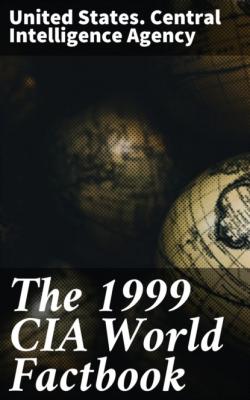The 1999 CIA World Factbook. United States. Central Intelligence Agency
Чтение книги онлайн.
Читать онлайн книгу The 1999 CIA World Factbook - United States. Central Intelligence Agency страница 14
 120 million kWh (1996)
120 million kWh (1996)
Agriculture—products: wheat, fruits, nuts, karakul pelts; wool, mutton
Exports: $80 million (1996 est.)
Exports—commodities: fruits and nuts, handwoven carpets, wool,
cotton, hides and pelts, precious and semi-precious gems
Exports—partners: FSU, Pakistan, Iran, Germany, India, UK,
Belgium, Luxembourg, Czech Republic
Imports: $150 million (1996 est.)
Imports—commodities: food and petroleum products; most consumer
goods
Imports—partners: FSU, Pakistan, Iran, Japan, Singapore, India,
South Korea, Germany
Debt—external: $2.3 billion (March 1991 est.)
Economic aid—recipient: $214.6 million (1995); note?US provided $450 million in bilateral assistance (1985–93); US continues to contribute to multilateral assistance through the UN programs of food aid, immunization, land mine removal, and a wide range of aid to refugees and displaced persons
Currency: 1 afghani (AF) = 100 puls
Exchange rates: afghanis (Af) per US$1—4,750 (February 1999), 17,000 (December 1996), 7,000 (January 1995), 1,900 (January 1994), 1,019 (March 1993), 850 (1991); note—these rates reflect the free market exchange rates rather than the official exchange rate, which was fixed at 50.600 afghanis to the dollar until 1996, when it rose to 2,262.65 per dollar, and finally became fixed again at 3,000.00 per dollar on April 1996
Fiscal year: 21 March—20 March
Communications
Telephones: 31,200 (1983 est.)
Telephone system:
domestic: very limited telephone and telegraph service; in 1997,
telecommunications links were established between Mazar-e Sharif,
Herat, Kandahar, Jalalabad, and Kabul through satellite and
microwave systems
international: satellite earth stations—1 Intelsat (Indian Ocean)
linked only to Iran and 1 Intersputnik (Atlantic Ocean region);
commercial satellite telephone center in Ghazni
Radio broadcast stations: AM 6 (5 are inactive), FM 1, shortwave
3 (1998)
Radios: 1.67 million (1998 est.)
Television broadcast stations: NA note: in 1997, there was a station in Mazar-e Sharif reaching four northern Afghanistan provinces; also, the government ran a central television station in Kabul and regional stations in nine of the 30 provinces; it is unknown if any of these stations currently operate
Televisions: 100,000 (1998 est.)
Transportation
Railways:
total: 24.6 km
broad gauge: 9.6 km 1.524-m gauge from Gushgy (Turkmenistan) to
Towraghondi; 15 km 1.524-m gauge from Termiz (Uzbekistan) to
Kheyrabad transshipment point on south bank of Amu Darya
Highways: total: 21,000 km paved: 2,793 km unpaved: 18,207 km (1996 est.)
Waterways: 1,200 km; chiefly Amu Darya, which handles vessels up
to about 500 DWT
Pipelines: petroleum products—Uzbekistan to Bagram and
Turkmenistan to Shindand; natural gas 180 km
Ports and harbors: Kheyrabad, Shir Khan
Merchant marine:
total: 1 container ship (1,000 GRT or over) totaling 11,982
GRT/14,101 DWT (1998 est.)
Airports: 44 (1998 est.)
Airports—with paved runways:
total: 11
over 3,047 m: 3
2,438 to 3,047 m: 4
1,524 to 2,437 m: 2
under 914 m: 2 (1998 est.)
Airports—with unpaved runways:
total: 33
2,438 to 3,047 m: 5
1,524 to 2,437 m: 14
914 to 1,523 m: 4
under 914 m: 10 (1998 est.)
Heliports: 3 (1998 est.)
Military
Military branches: NA; note—the military does not exist on a national basis; some elements of the former Army, Air and Air Defense Forces, National Guard, Border Guard Forces, National Police Force (Sarandoi), and tribal militias still exist but are factionalized among the various groups
Military manpower—military age: 22 years of age
Military manpower—availability:
males age 15–49: 6,326,135 (1999 est.)
Military manpower—fit for military service:
males age 15–49: 3,392,336 (1999 est.)
Military manpower—reaching military age annually:
males: 248,320 (1999 est.)
Military expenditures—dollar figure: $NA
Military expenditures—percent of GDP: NA%
Transnational Issues
Disputes—international: support to Islamic militants worldwide by some factions; question over which group should hold Afghanistan's seat at the UN
Illicit drugs: world's second-largest illicit opium producer after Burma (cultivation in 1998—41,720 hectares, a 7% increase over 1997; potential production in 1998—1,350 metric tons) and a major source of hashish; increasing number of heroin-processing laboratories being set up in the country; major political factions in the country profit from drug trade
======================================================================
@Albania———
Geography
Location: